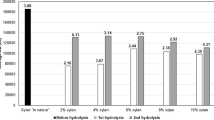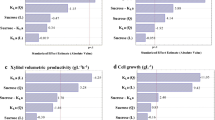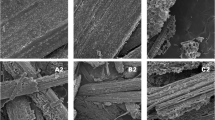Abstract
Dilute-acid hydrolysis pretreatment of sugarcane bagasse resulted in release of 48% (18.4 g/L) of the xylan in the hemicellulose fraction into the hydrolysate as monomeric xylose. In order to enhance the recuperation of this monomer, a post-hydrolysis stage consisted of thermal treatment was carried out. This treatment resulted in an increase in xylose release of 62% (23.5 g/L) of the hemicellulose fraction. Original and post-hydrolysates were concentrated to the same levels of monomeric xylose in the fermentor feed. During the fermentation process, cellular growth was observed to be higher in the post-hydrolysate (3.5 g/L, Y x/s = 0.075 g cells/g xylose) than in the original hydrolysate (2.9 g/L, Y x/s = 0.068 g cells/g xylose). The post-treated hydrolysate required less concentration of sugars resulting in a lower concentration of fermentation inhibitors, which were formed primarily in the dilute acid hydrolysis step. Post-hydrolysis step led to a high xylose–xylitol conversion efficiency of 76% (0.7 g xylitol/g xylose) and volumetric productivity of 0.68 g xylitol/L h when compared to 71% (0.65 g xylitol/g xylose and productivity of 0.61 g xylitol/L h) for the original hemicellulosic hydrolysate.

Similar content being viewed by others
References
Sarrouh, B. F., Santos, D. T., & Silva, S. S. (2007). Biotechnology Journal, 2, 759–763. doi:10.1002/biot.200600207.
Silva, C. J. S. M., Mussatto, S. I., & Roberto, I. C. (2006). Journal of Food Engineering, 75, 115–119. doi:10.1016/j.jfoodeng.2005.04.001.
Rao, S. R., Jyothi, P. C., Prakasham, R. S., Sarma, P. N., & Rao, V. L. (2006). Bioresource Technology, 97, 1974–1978. doi:10.1016/j.biortech.2005.08.015.
Rodrigues, R. C. L. B., Felipe, M. G., Almeida e Silva, J. B., & Vitolo, M. (2003). Process Biochemistry, 38, 1231–1237. doi:10.1016/S0032-9592(02)00290-X.
Kim, J. H., Ryu, Y. W., & Seo, J. H. (1999). Journal of Industrial Microbiology & Biotechnology, 22, 181–186. doi:10.1038/sj.jim.2900626.
Parajó, J. C., Dominguez, H., & Dominguez, J. M. (1996). Biotechnology Letters, 18, 593–598. doi:10.1007/BF00140209.
Silva, S. S., Felipe, M. G. A., & Mancilha, I. M. (1998). Applied Biochemistry and Biotechnology, 70/72, 331–340. doi:10.1007/BF02920149.
du Toit, P. J., Olivier, S. P., & van Bijon, P. L. (1984). Biotechnology and Bioengineering, 26, 1071–1078. doi:10.1002/bit.260260909.
Tsao, G. T., Cao, N., & Gong, C. S. (1999). In Encyclopedia of bioprocess technology: Fermentation, biocatalysis and bioseperation (vol. 3, pp. 1391–1400). New York: Wiley.
Rivas, B., Domínguez, J. M., Domínguez, H., & Parajó, J. C. (2002). Enzyme and Microbial Technology, 31, 431–438. doi:10.1016/S0141-0229(02)00098-4.
Browning, B. L. (1967). Methods of wood chemistry. New York: Wiley.
Alves, L. A., Felipe, M. G. A., Silva, J. B. A., Silva, S. S., & Prata, A. M. R. (1998). Applied Biochemistry and Biotechnology, 70/72, 89–98. doi:10.1007/BF02920126.
Barbosa, M. F. S., Medeiros, M. B., Mancilha, I. M., Schneider, H., & Lee, H. (1988). Journal of Industrial Microbiology, 3, 241–251. doi:10.1007/BF01569582.
Rocha, G. J. M. (2000) PhD thesis São Paulo, São Paulo University, Chemical Instittute of São Carlos. (pp 37–38).
Singleton, V. L., Orthofer, R., & Lamuela-Raventos, R. M. (1999). Methods in Enzymology, 299, 152–178. doi:10.1016/S0076-6879(99)99017-1.
Aguilar, R. J., Ramírez, A., Garrote, G., & Vazquez, M. (2002). Journal of Food Engineering, 55, 309–318. doi:10.1016/S0260-8774(02)00106-1.
Shevchenko, S. M., Chang, K., Robinson, J., & Saddler, J. N. (2002). Bioresource Technology, 72, 207–211. doi:10.1016/S0960-8524(99)00125-X.
Acknowledgement
The authors would like to thank FAPÈSP for its financial support.
Author information
Authors and Affiliations
Corresponding author
Rights and permissions
About this article
Cite this article
Sarrouh, B.F., de Freitas Branco, R. & da Silva, S.S. Biotechnological Production of Xylitol: Enhancement of Monosaccharide Production by Post-Hydrolysis of Dilute Acid Sugarcane Hydrolysate. Appl Biochem Biotechnol 153, 163–170 (2009). https://doi.org/10.1007/s12010-009-8548-5
Received:
Accepted:
Published:
Issue Date:
DOI: https://doi.org/10.1007/s12010-009-8548-5




